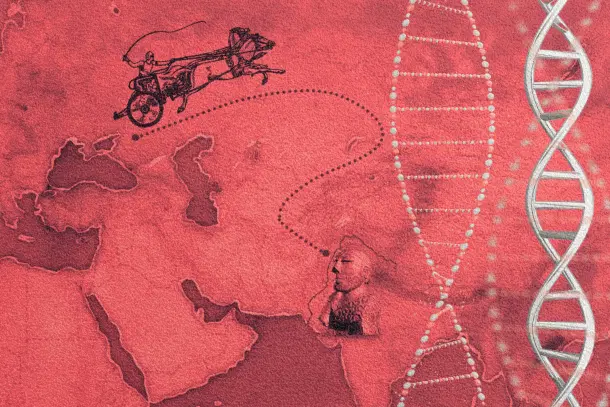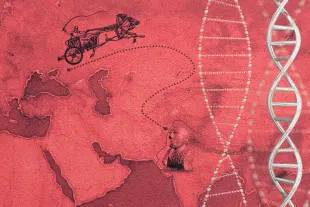Ideas
No, Genetics Has Not Conclusively Proven Indo-European Migration
Anil Kumar Suri
Jul 21, 2025, 02:45 PM | Updated 02:45 PM IST
Save & read from anywhere!
Bookmark stories for easy access on any device or the Swarajya app.


Now that the topic has been hotting up once again, it is time to take a critical look at the claim that genetics has come up with irrefutable evidence of migrations of Bronze Age pastoralists from the Steppe into the Indian subcontinent.
These migrations supposedly happened in the 2nd millennium BCE (2000–1000 BCE), and are claimed to have been responsible for introducing Indo-European (IE) languages and culture to the subcontinent.
Without going into the merits and demerits of the arguments about the origin and supposed spread of IE languages – and, no, not many scholars are convinced by the flurry of papers in top-ranking journals like Nature and Science in the last decade – let us examine the precise methodology used by the genetics studies. Let us “look under the hood”.
Even complete outsiders to the topic are aware that, unfortunately, there is virtually no ancient DNA (aDNA) from the subcontinent. Palaeolithic, Mesolithic, Neolithic, Chalcolithic, Bronze Age (barring the one Rakhigarhi sample of very low coverage), and even historic – all periods have drawn a blank as far as aDNA samples are concerned.
This is owing to the poor preservation of genetic material in the subcontinent’s tropical climate – a temperature that is, on average, at least ten degrees Centigrade higher than that in the temperate regions where aDNA samples have been found and studied: the Steppe, Europe, Anatolia and even Iran. There is also the likely overwhelming historical preference for cremation or exposure for disposing of the dead on the subcontinent. But, again, we digress.
The question we are interested in answering is, how did the genetic analyses study the possible admixture of ancient Indians with other populations? How does one figure out what genes exactly underwent admixture with those of the Steppe people to give rise to modern Indian populations?
The genetics studies tried to solve this problem by representing ancient Indians with a proxy. The proxy they chose was the present-day Andamanese tribe, the Onge. And thereby hangs a tale.
“First Out-of-Africa settlers”
For a long time, there was a romantic notion that, when the first anatomically modern human migrants from Africa reached the subcontinent around 70,000 years ago, some of them kept moving along the coast and eventually reached what are the Andaman and Nicobar Islands.
Owing to being isolated on the archipelago, they escaped all the developments that happened on the mainland, including the advent of farming, and the Iron and Bronze Ages, retaining to this day the primitive hunter-gatherer lifestyle of our earliest ancestors. They have been called Negritos owing to their relatively short stature, dark skin and distinct hair.
In other words, the Andamanese tribes were the direct, “pristine” descendants of the first Out-of-Africa (OoA) migrants to reach the subcontinent, who underwent no intermingling with any other populations since reaching the islands tens of thousands of years ago.
Can you think of a better proxy to represent ancient Indians?
The hitch is that geneticists like Prof. Gyaneshwer Chaubey have clearly proved that this romantic theory about the Andamanese is not correct. In fact, the Andamanese cannot be described as a subcontinental population at all. They are, as it turns out, the relics of an ancestral Southeast Asian population, who probably wandered onto what are now the Andaman Islands sometime within the last 25,000 years (and the Nicobarese tribes reached the Nicobar Islands much later still).
Before sea levels rose over a hundred metres in the last 12,000 years (often with sudden sea-level rise episodes), Southeast Asia was a much larger landmass. A great deal of this landmass, which geologists call Sundaland, was submerged. When the seas rose, the Andamanese tribals were stranded on the islands, which remained above sea-level owing to their elevation.
Thus, these populations are genetically quite distant from subcontinental ones, and are not at all satisfactorily representative of them.
Some geneticists have subsequently pointed out that the Onge are not a suitable proxy for ancient subcontinental populations, and other mainland populations like the Paniya or Pulliyar of South India would be more accurate.
Onge as a proxy may also be responsible for the fact that the genetics studies do not find Indian ancestry in populations outside India to the extent that they might without their erroneous methodology.
Evidence suggests there has been no significant reduction in the population of the subcontinent after its initial settlement around 70,000 years ago. During the Last Glacial Maximum (26–19,000 years ago), when global temperatures were significantly lower and ice sheets had expanded to their maximum extent, India is estimated to have supported nearly half the then global population.
It is also commonly accepted that the Indus Valley Civilisation sustained a high population density through the 3rd millennium BCE. Thus, demographic change on the subcontinent is likely a process of continuous amalgamation rather than population replacement. It is therefore quite challenging to identify any major migratory influx that significantly altered the ancestral composition of India's population.
The very different conclusions of Shriner et al.
While the studies which claim to have found evidence of massive migration from the Steppe received – and continue to receive – high-decibel coverage, it is not as if there are no peer-reviewed genetics papers at all that arrived at very different conclusions.
Using a very different approach, and importantly one that is free from any assumptions – of simply allowing the computer program to work out the ancestral components of present-day populations all over the world – Shriner et al. obtained a very different picture.
In a stunning reversal, over a quarter of the ancestry of Bronze Age Steppe pastoralists themselves was found to be South Asian, one of the two dominant ancestries of the Indian subcontinent (the other being South Indian).
What is more, virtually every Bronze Age and modern European population sampled had a small proportion of South Asian ancestry. If one must find a common genetic thread connecting all present-day Indo-European speakers, then the findings of Shriner et al. suggest it is South Asian ancestry.
The authors do wonder if their strikingly different results are owing to earlier studies having worked with the Onge as a proxy for subcontinental populations.
One is left wondering what exactly is meant by the so-called “Steppe ancestry”, which itself turns out to be a mosaic of multiple ancestries, including, as mentioned earlier, South Asian.
This implies that the Copper and Bronze Age Steppe pastoralist communities were themselves formed by the amalgamation of sundry groups that converged on the vast Steppe some 6–5,000 years ago. Among these were Indian groups as well, that migrated northwards during the mid-Holocene, when the climate was a lot wetter than it is today.
It is a well-established fact that, during the Last Glacial Maximum, many parts of Eurasia, including Iran, the Caucasus and Central Asia, were depopulated by the unbearably harsh climate. On the Indian subcontinent, however, the relatively clement conditions allowed people to not only thrive but also increase in numbers.
When the climate improved, and especially after agriculture began, there was increased pressure on land and resources. It is likely many subcontinental groups that were sustaining themselves by herding and foraging were edged out, and moved northwards.
Central Asia was attractive because it had transformed into a vast, open grassland with very little competition. Other independent genetic analyses have confirmed the Bronze Age Steppe pastoralist populations were formed only in the 5th millennium BCE.
Final thoughts
To cut a long story short, do not be swayed by anyone telling you genetics has provided conclusive proof of Indo-European migration. There is no proof. The claims of the geneticists are based on a very questionable assumption, which other geneticists have expressed reservations about.
And yes, there are other peer-reviewed studies painting a very different scenario.
Also, do not let anyone wave the reputation of Nature and Science in your face as proof that the studies are beyond debate. There have been instances in the past of papers with glaring errors getting published in the most reputed of journals, and even cited thousands of times by subsequent studies – referring to the errors, of course, but if you took the number of citations at face value, you would think they were path-breaking studies.
Acknowledgement: The author is very grateful to Prof. Gyaneshwer Chaubey, Banaras Hindu University, for insights and stimulating discussions.
Anil Kumar is a materials scientist.





